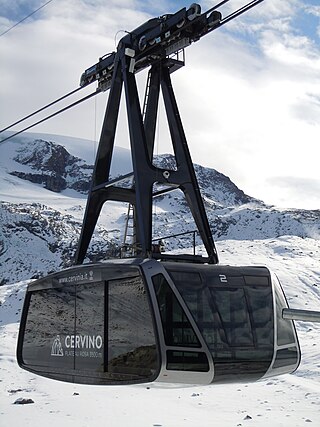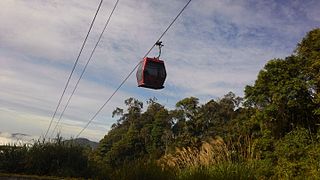Ropeway may refer to:
Ropeway may refer to:

Cable transport is a broad class of transport modes that have cables. They transport passengers and goods, often in vehicles called cable cars. The cable may be driven or passive, and items may be moved by pulling, sliding, sailing, or by drives within the object being moved on cableways. The use of pulleys and balancing of loads moving up and down are common elements of cable transport. They are often used in mountainous areas where cable haulage can overcome large differences in elevation.

An aerial tramway, aerial tram, sky tram, aerial cablecar, aerial cableway, telepherique, or seilbahn is a type of aerial lift which uses one or two stationary ropes for support while a third moving rope provides propulsion. With this form of lift, the grip of an aerial tramway cabin is fixed onto the propulsion rope and cannot be decoupled from it during operations. In comparison to gondola lifts, aerial tramways generally provide lower line capacities and longer wait times.

A gondola lift is a means of cable transport and type of aerial lift which is supported and propelled by cables from above. It consists of a loop of steel wire rope that is strung between two stations, sometimes over intermediate supporting towers. The cable is driven by a bullwheel in a terminal, which is typically connected to an engine or electric motor. It is often considered a continuous system since it features a haul rope which continuously moves and circulates around two terminal stations. In contrast, an aerial tramway operates solely with fixed grips and simply shuttles back and forth between two end terminals.

A funitel is a type of cableway, generally used to transport skiers, although at least one is used to transport finished cars between different areas of a factory. It differs from a standard gondola lift through the use of two arms attached to two parallel overhead cables, providing more stability in high winds. The name funitel is a portmanteau of the French words funiculaire and telepherique.

Doppelmayr/Garaventa Group is an international manufacturer of ropeways and people movers for ski areas, urban transport, amusement parks, and material handling systems. As of 2023, the group had produced over 15,400 installations in 96 countries. Their annual revenue in 2022/2023 was 946 million euros. The Doppelmayr/Garaventa Group was formed in 2002 when Doppelmayr of Wolfurt, Austria merged with Garaventa AG of Switzerland to form the world's largest ropeway manufacturer.

An aerial lift, also known as a cable car or ropeway, is a means of cable transport in which cabins, cars, gondolas, or open chairs are hauled above the ground by means of one or more cables. Aerial lift systems are frequently employed in a mountainous territory where roads are relatively difficult to build and use, and have seen extensive use in mining. Aerial lift systems are relatively easy to move and have been used to cross rivers and ravines. In more recent times, the cost-effectiveness and flexibility of aerial lifts have seen an increase of gondola lift being integrated into urban public transport systems.

The Singapore Cable Car is a gondola lift in Singapore, providing an aerial link from Mount Faber on Singapore Island to the resort island of Sentosa across the Keppel Harbour.

Ngong Ping 360 is a bicable gondola lift on Lantau Island in Hong Kong. Intended to improve tourism to the area, the aerial lift was previously known as Tung Chung Cable Car Project before acquiring the Ngong Ping 360 brand in April 2005. It consists of the Ngong Ping Cable Car, formerly known as the Ngong Ping 360 Skyrail, and the Ngong Ping Village, a retail and entertainment centre adjacent to the cable car's upper station. Ngong Ping 360 connects Tung Chung, on the north coast of Lantau and itself linked to central Hong Kong by the Tung Chung line, with the Ngong Ping area in the hills above. This is home to the Po Lin Monastery and the Tian Tan Buddha, both already significant tourist attractions in their own right. Before Ngong Ping 360's opening, the only access was via a mountain road and bus service.

Norsjö aerial tramway is a 13.2 kilometre long aerial tramway between Örträsk and Mensträsk in the Norsjö Municipality in Sweden.
Poma, incorporated as Pomagalski S.A., and sometimes referred to as the Poma Group, is a French company which manufactures cable-driven lift systems, including fixed and detachable chairlifts, gondola lifts, funiculars, aerial tramways, people movers, and surface lifts. Poma has installed about 7800 devices for 750 customers worldwide.

The tricable gondola lift, also known as the 3S gondola lift, is a cable car system that was developed by the Swiss company Von Roll transport systems in Thun to unite the benefits of a gondola lift with those of a reversible cable car system. '3S' is an abbreviation of the German word dreiseil, meaning 'tricable'.

The Tanigawadake Ropeway is Japanese cable car line, operated by Tanigawadake Ropeway Company. The Tōbu Group company also operates another aerial lift line, Harunasan Ropeway. Opened in 1960, the line climbs Mount Tanigawa Tenjindaira Ski Resort, Minakami, Gunma. The line is operated all seasons, transporting skiers, hikers, or tourists.

Gulmarg Gondola in Gulmarg, Jammu and Kashmir,is the second longest and second highest cable car in the world. Higher lines include the Mi Teleférico in Bolivia and at Jade Dragon Snow Mountain.

The Eyüp Gondola, a.k.a. Eyüp–Piyerloti Aerial Cable Car, is a two-station gondola-type line of aerial lift passenger transport system located in Eyüp district of Istanbul, Turkey. Opened on November 30, 2005, the 420 m (1,380 ft) long line serves the Piyerloti Hill from Eyüp at the coast of Golden Horn. It is operated under the line number TF2 by Metro Istanbul. The fare is paid by the contactless smart card Istanbulkart, which is valid for all public transport in Istanbul.

The Genting Highlands Premium Outlets Cable Car, is a gondola lift system connecting Awana Transport Hub, Chin Swee Temple and SkyAvenue in Genting Highlands, Pahang, Malaysia since December 2016. The Awana Transport Hub terminus consists of the new Genting Highlands Premium Outlets Terminal, the station building and a new 8-storey car park while the other terminus is located at SkyAvenue.

The Heights of Abraham Cable Car is a gondola lift in the English county of Derbyshire. About 1/3 of a mile long, it links the spa town of Matlock Bath with the Heights of Abraham, a tourist attraction 554 feet (169 m) above. The line was built by Poma and opened in spring of 1984. The cable cars were upgraded in 2004, making them larger and more accessible, to 12 x six-seater cabins, which operate in four trains of three cabins each. An example of the smaller 1984 cabin can be seen displayed at the base station

The ropeway in India is a public transportation system where cabins, gondolas or open chairs are hauled above the ground with the help of cables. India's Parvatmala Scheme, the world's largest ropeway project, envisages spending ₹1,250 billion (US$15 billion) in public–private partnership (PPP) mode over five years till 2030 to build 200 new ropeway projects of more than 1200 km length, which will decongest the traffic in narrow roads of big cities and provide cheaper connectivity in mountainous and touristy areas. Since 30% of India is covered by mountains, the ropeways are specially useful in mountainous areas, where it is difficult to build roads or railway, as lower cost and higher Return on investment (ROI) projects. Rajgir Ropeway in Bihar, 333m-long chairlift ropeway built in 1960s, is India's first ropeway. As of 2024, the 4 km-long Auli Ropeway in Uttarakhand is India's longest and world's the second-longest ropeway behind Vietnam's 7,899.9 m long Hòn Thơm cable car, and when completed the under-construction 5.5 km-long Mussoorie-Dehradun Ropeway will be the longest in India. Kashi ropeway is India's first urban ropeway, and world's third urban public transport ropeway behind Bolivia's Mi Teleférico opened in 2014 and Mexico City's Mexicable opened in 2021. This article also contains a list of "glass bridges in India", which are mostly glass bridge skywalk.